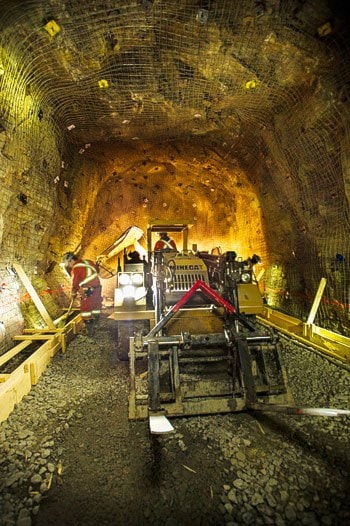Minto mine
Original plans called for Minto to start closing down this year. Instead, Capstone Mining Corp. has doubled its mining rate and is building new, multiple-storey trailers to house its burgeoning employee base until 2022.
The copper mine sits nearly 30 kilometres from the Alaska Highway, down a dusty gravel road on the west side of the Yukon River near Pelly Crossing.
Anyone driving to the mine must either wait for the company’s barge that travels back and forth across the fast-flowing river in the summer months, or navigate across an ice bridge in the winter.
Within less than a half hour, one truck with two trailers laden with about 60 to 70 tonnes of copper concentrate headed for the Skagway port drives off the barge and another one pulls up to the river’s shore, waiting for its chance to drive on.
About a dozen or more of these trucks leave the site every day, said Cindy Burnett, vice-president of investor relations for Capstone.
All of that concentrate eventually makes its way to Asia. It contains about 40 per cent copper, which is currently trading at about $3.50 per pound. That means each truck is carrying anywhere from $420,000 to $490,000.
Along the road to the mine, the view is filled with sticks standing like porcupine quills from the backs of the hills and valleys. They are the charred remains of a massive forest fire in 2010.
The mine is high above the river and stretches on for kilometres.
The airstrip is perched up high on a far southern tip. Massive shelves of tailings stretch across most of the middle of the property. The mine’s second open pit, which has been blasted and scraped since April and has an expected four years’ work left in it, is in the centre-west of the property.
Far to the north stands the mine’s first pit, which has already been mined for all it’s worth. Piles of waste rock surrounding it already show a growing cap of green as the company starts its reclamation work.
Just east of that is the large mill. Here, the rock - which has been blasted from the earth and already crushed twice - gets ground into sand-like ore concentrate and dumped into big tanks of water. Different chemicals are poured in, causing copper to float to the top.
The surface is skimmed and loaded into the trucks, while the waste at the bottom gets stacked, dried and eventually reclaimed.
East of the mill is the current camp. It, like the mine’s original lifespan, is much too small for the mine now. Nine new discoveries have extended the project’s life by a decade.
Exploration continues every summer season, said Burnett, motioning to the green outskirts of the property. Last year’s exploration project totalled $6.7 million, she said.
Minto’s new, bigger camp, which includes a bigger cafeteria and still boasts a gym, game room and offices, is expected to be ready by next spring. Right now, all the rooms at the site are full, and another 50 workers are expected before the end of this month to start developing a new underground portion of the mine, said Burnett.
Trucks preparing the new underground entrance and ramp look like little ants from the view from camp. Underground operations are expected to start extracting ore by next fall.
When Capstone first started Minto in 2007, it only expected the mine to last for five, maybe six years.
There are currently 306 year-round employees, said Burnett. Just over half of whom are Yukoners; 20 per cent are female, 26 per cent are aboriginal and 100 per cent are Canadian.
Total production counts from 2007 to date are 171 billion pounds of copper, 870,000 ounces of silver, 84,000 ounces of gold and some lead and zinc values.
“Capstone, I want to say, is definitely committed to the Yukon,” said Darren Pylot, CEO, president and director of the company. “The policy is, wherever possible, to use local suppliers, services, materials and employees.”
Local contracting and hire has resulted in more than $225 million flowing back to the North, said Pylot.
When it comes to licensing and royalties, the Yukon and Selkirk First Nation governments have received more than $31 million since the mine was opened in 2007, he said, adding that does not include corporate taxes.
The first hard-rock mine since devolution is also the territory’s only mine on First Nation settlement land. The Selkirk First Nation selected the land in its land claims and owns both the land and any minerals underneath it. Leasing, royalties and benefits agreements with Capstone have been negotiated by the First Nation, although all royalties go to the territory, and the Yukon government then pays Selkirk.
Capstone invests in the community in other ways too, said Pylot. It just helped build a drinking-water treatment plant with the Selkirk First Nation for Pelly Crossing. In 2010, Capstone gave $3 million to the new B.C. Children’s Hospital, which supports young Yukoners, and has helped the Whitehorse General Hospital purchase a new digital X-ray and MRI, said Pylot.
Annually, the company also supports local organizations like the Whitehorse Food Bank, Relay for Life, Yukon Special Olympics and various community and sports teams totaling more than $335,000 to date, he said.
Capstone has one other major project in Mexico, which is producing commercially. It also has two more projects expected to start production soon, one in B.C. and one in Chile, said Pylot.
The Minto mine is one of three mines in production in the territory. The other two are Yukon Zinc’s underground Wolverine Mine near Ross River which produces lead, zinc, copper, silver and gold and Alexco’s Bellekeno silver mine near Keno City in central Yukon.
Contact Roxanne Stasyszyn at
roxannes@yukon-news.com
